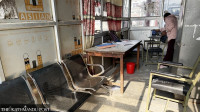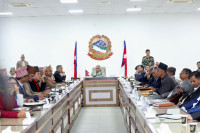National
Why Nepal, rich in water resources, is facing water stress today
A visit to Bagmati earlier this month (June) shows that the life-giving brook has been reduced to stagnant, murky brown water, chock-full of chunks of litter like plastic waste and bits of cloth.
Asia News Network
Nepal, like Singapore, is one of the most water-stressed countries in the world.
But where Singapore lacks access to natural water resources, Nepal has plenty - rivers fed by meltwater from the glaciers in the Himalayas and groundwater aquifers charged up by rain.
But as I recently discovered during a trip to Kathmandu, the water resources in Nepal are coming under threat from rapid urbanisation, pollution and climate change - issues that also plague many other cities today.
The Intergovernmental Panel on Climate Change (IPCC) had in February (2022) warned that water shortages, which already plague half the world’s population at some point in a year, could become worse due to erratic rainfall patterns or extreme events such as floods or droughts.
Such dry conditions could negatively affect agriculture and energy production from hydroelectric power plants, said the report.
Now, organisations in Nepal are working with various partners, including researchers from Singapore, to help the country to safeguard its water resources.
Threats to water security
The famed Bagmati River, which runs through the Kathmandu Valley, is revered by Hindus and Buddhists because its water is thought to be holy.
Several Hindu temples are located on its banks, and Hindus are cremated on the banks as well.
But the state of the river now is a far cry from what it was in the 1970s.
A visit to the river earlier this month (June) shows that the life-giving brook has been reduced to stagnant, murky brown water, chock-full of chunks of litter like plastic waste and bits of cloth.
The cause of the pollution? Concrete, carpet and other industries dumping their waste in the river, and households doing the same with their sewage, said freelance climate change and senior watershed expert Madhukar Upadhya.
Recounted the 68-year-old: “Back then, there were no rules governing waste disposal, and people thought we had enough water, so we could just wash everything away - which was true back then, as the population was not as high.”
Mr Upadhya, who used to do his laundry and take baths in the river, said that, as Kathmandu Valley did not have good municipal water supply back in the 1960s and 70s, the river was an important part of people’s lives.
The 1990s heralded the age of rapid urbanisation in Nepal, but it was not until 2011 that rules forbidding the dumping of solid and industrial waste were implemented. Even then, this was largely ignored.
Stricter rules now are helping to change people’s mindsets, said Mr Upadhya, who still lives in Kathmandu today.
River sampling efforts by the Nanyang Technological University’s Nanyang Environment and Water Research Institute (Newri) has found that in certain sections of the river, the water is highly toxic to human cells, and that there is an unusual amount of pharmaceutical discharge, including antibiotics, which could lead to antibiotic resistance, said its executive director Shane Snyder.
But the source of this pharmaceutical discharge remains unknown, he noted.
Mr Upadhya said: “The problem that the Bagmati River is facing is the fact that it has lost its ability to flush out these pollutants, and clean itself naturally.”
For one, the Bagmati River now has a decreasing watershed. This refers to the parcel of land that channels rainfall to groundwater beneath the earth’s surface, which in turn feeds rivers like the Bagmati.
“The greater the amount of rainfall that is stored as groundwater, the richer the watershed becomes, because it can continue to feed rivers like the Bagmati during the drier seasons,” said Mr Upadhya.
However, rapid urbanisation in the valley has seen 80 percent of the valley floor being sealed by roads and buildings in the past 40 years, which makes it impossible for rainwater to seep into the ground, he added.
“Many traditional ponds that collected rainwater and contributed to groundwater recharge have also been lost to other structures due to unplanned urbanisation,” he said.
At the same time, the amount of rain falling over Nepal is also becoming increasingly erratic due to climate change.
Climate change expert Raju Pandit Chhetri, the executive director of Prakriti Resources Centre, a non-governmental organisation working on sustainable development and environmental justice in Nepal, said that rainfall during the monsoon season is becoming more erratic. The season usually begins in the first week of June and lasts for around three months, till early September.
“What’s happening nowadays is that you often get a very heavy downpour in a single day, but dry weather during the rest of the week,” said Mr Chhetri.
This is opposed to rainfall being more consistently spread out over the week.
Another IPCC report published in August last year warned that the water cycle has been intensifying and will continue to intensify as the planet warms. This means more wet and dry extremes that will increase with future warming.
Heavy rainfall could also have more disastrous effects, such as crop losses among farmers and triggering landslides and flooding in various areas around the country.
And, while rain might be in shortfall during some periods, too much rain during other periods have also led to disastrous consequences.
Solutions
Singapore has been able to overcome its water scarcity through building expansive infrastructure, such as used-water treatment plants and desalination facilities that purify sea water. But experts say such interventions may not be as suitable for Nepal, especially if these are not adapted to climate change.
For instance, the Melamchi Water Supply Project, an initiative of the Nepalese government that took more than two decades to build, was designed to divert about 170 million litres of fresh water daily from the Melamchi River through a 26km long tunnel to Kathmandu.
This accounted for less than half of Kathmandu’s daily water demand.
But unexpectedly heavy rainfall followed by a landslide caused significant damage to the tunnel on June 15 last year, just months after it began operations. The tunnel was also closed this year ahead of the monsoon season to prevent a similar occurrence.
The project worth $35 billion rupees (S$388 million) now faces a lot of uncertainty, especially as it has been 20 years in the making, and it is not well adapted to the changing climate, said Mr Upadhya.
“Now, with there being more extreme weather events occurring due to climate change, we don’t know what the future will hold for this project, and whether it is still viable in the long term,” he added.
Instead, Mr Upadhya proposes simple, small-scale solutions that work as closely with nature as possible.
For instance, creating small ponds by trapping rainwater in certain areas of the watershed can allow water to re-enter the earth, and recharge groundwater reserves.
This has been trialled by the International Centre for Integrated Mountain Development in several villages in Kavre - a district east of Kathmandu - after an earthquake there had caused some springs to run dry.
In the southern lowlands of Nepal, in a district called Nawalparasi, Singapore’s Newri team partnered local organisations there to install water filtration systems in two secondary schools, which helped remove arsenic from their drinking water.
More importantly, Mr Upadhya hopes for more to be done to conserve and restore the rivers and tributaries in the Kathmandu Valley, so that they do not suffer the same fate as the Bagmati.
“We still need our rivers and to tap our own groundwater resources to keep us alive. And if all that is gone, then where do we get our water from?
“When responding to climate change and our rapidly depleting resources, our approach tends to often be short term and political in nature, involving large projects which fail to recognise the way in which different natural resources are linked and the complex processes involved. The costs of this can be expensive, and could inadvertently lead to maladaptation.”
“More long-term solutions and climate adaptation options must be considered for us to safeguard our water security,” he added.
This article was previously published in The Straits Times which is a part of Asia News Network.




 17.12°C Kathmandu
17.12°C Kathmandu















